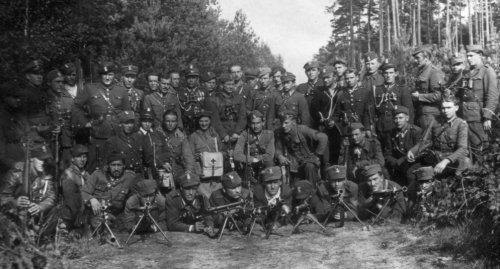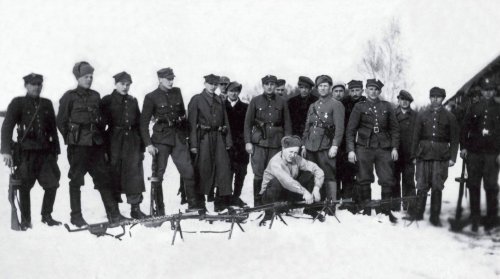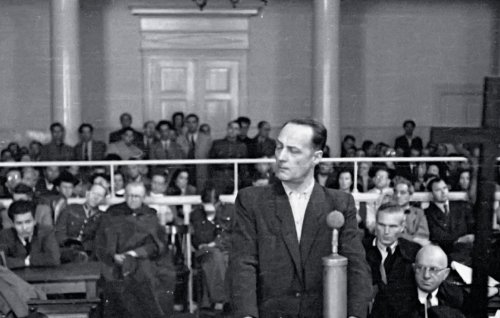The taking of Poland by the Red Army, the Soviet terror and building of state structures by the Polish communists subordinate to the USSR, forced the underground army to change its forms of activities. The words the soldiers of the Home Army [AK – Armia Krajowa] heard after they swore their oath did not come to fruition: “Victory will be your reward”. There was no victory and the last commander, gen. Leopold Okulicki codename “Niedźwiadek” thought the Home Army to be too big of an organisation and too compromised to base further activities aiming to bring back Poland’s sovereignty on it. On January 19th 1945, the Home Army was disbanded. In the last order, the soldiers heard that they were to continue to fight for independence, but on new terms, each was to be their own commander. Okulicki’s decision probably saved many soldiers of the Home Army from repressions, but it also introduced chaos by depriving them of clear instructions on what to do next. What’s more, due to that order, masses of Home Army soldiers were not automatically engaged in an organised resistance against the new power and the post-war underground became so varied.
AK – NIE – DSZ
However, there was no void after the underground army which counted 400 thousand soldiers. On one side, the structures of the Home Army in Liquidation were created, taking on, among other things, the management of material goods, sorting of personal affairs (pays, promotions) or documentation of the previous activities. On the other side, the “NIE” organisation had been created by gen. August Fieldorf codename “Nil”, since spring of 1944, to prepare for the new Soviet occupation.
Nonetheless, this structure did not fulfil the hopes for it, it failed to widen its activities and, following the arrest of gen. Okulicki and 16 commanders of the Polish Underground, it was deemed as compromised and was disbanded. The attempt to reorganise the former Home Army soldiers – to both shield them from repressions and reckless actions and to realise new goals – was the Delegation of the Armed Forces for Poland [DSZ – Delegatura Sił Zbrojnych na Kraj], founded on May 7th 1945. It was led by the former head of the Bureau of Information and Propaganda of the Home Army, col. Jan Rzepecki codename “Ożóg”. According to Rzepecki’s concept, the Delegation attempted to limit the armed operations, encourage the former Home Army soldiers to act openly and join the work to rebuild Poland after the war damage, after giving up on actions which could escalate tension and provoke repressions. However, these appeals could not convince the soldiers who were unable to return to normal, civilian lives precisely because of the repressions of the NKVD and Security Office and who were forced to return “to the woods”.
Social-political organisation
In June 1945, the creation of the Temporary Government of National Unity changed Poland’s situation. The allies acknowledged the new government, hoping it would conduct free elections. The leaders of the Polish underground adapted their strategies to the new conditions, hoping for a political breakthrough after a win of the legally operating opposition. At the same time, it was established that the continuation of the armed conspiracy was pointless. On August 6th 1945, the Delegation of the Armed Forces for Poland was disbanded. In the disbanding order, col. Rzepecki expressed his hopes that the former soldiers of the Home Army would be building the future of the new Poland “under the slogan of the citizens’ freedom and independence of the statehood”.
The new form of fighting for “the citizens’ freedom and independence of the statehood” was to be led by a new organisation. On September 2nd 1945, at the Warsaw district of Żoliborz, a meeting took place between five colonels, former officers of the Home Army and the previous command of the Delegation of the Armed Forces for Poland – Jan Rzepecki, Antoni Sanojcy, Janusz Bokszczanin, Franciszek Niepokólczycki and Jan Szczurek-Cergowski. It was then, that the Organisation “Freedom and Independence” [WiN – Wolność i Niezawisłość] was founded. Under the initial name of “Resistance without War and Diversion Freedom and Independence”, the basic rules of the organisation were created, which was to give up on its military character and restructure to a civilian operation. According to this notion, the internal structure was established – individual divisions were to be led by managements, not commands, and their leaders were to be chairmen, not commanders.
The president of the “Freedom and Independence” became Rzepecki. Among his associates were, among others, deputy chairman Janusz Bokszczanin and secretary general Tadeusz Jachimek codename “Ninka”. The organisation was divided into three zones. The Central Zone covered the Białostok, Lublin, Warsaw, Łódź and Kielce provinces. It was governed by Józef Rybicki codename “Maciej”. The Southern Zone, covering Lesser Poland and Silesia, was led by Antoni Sanojca codename “Cis”, followed by Franciszek Niepokólczycki codename “Żejmian”. The weakest was the Western Zone, managed by Jan Szczurek-Cegrowski codename “Sławbor”. It covered the Greater Poland and Pomorze provinces. The further expansion of the structure in the field was planned, often practically identical to the previous Home Army structures.


We will not allow to rig the elections
The creation of WiN came from the assumption that the fate of Poland would be determined in the country, through politics, and that the Polish government-in-exile lost real influence on the matter.
Therefore, WiN cut itself off from the exiled authorities and the previous rule of legality of the underground resistance. In turn, they demanded to enable the exiled politicians to return to the country and for the world powers to reconsider the matter of the Polish eastern border.
The organisers of Freedom and Independence saw the chance to regain freedom in the elections guaranteed by the western powers. The goal of the conspiracy organisation was to fight for the elections to be conducted honestly and to support the openly active political groups with the program for independence – de facto meaning the Polish People’s Party of Stanisław Mikołajczyk. The society needed to be protected from the communist propaganda and the pre-election terror of the authorities had to be resisted. In the last words of the declaration of the organisation it was written:
We demand for the elections to be preceded by the introduction of the right for association, freedom of press and electoral propaganda, removal of the foreign secret police and foreign army from the country. We will not allow to rig the elections!!!
WiN was not a uniform organisation and did not take the shape announced in its preliminary assumptions. In the Central Zone, especially on its eastern side, it simply functioned as the extension of the Home Army. The soldiers themselves treated the organisation this way, not having faith in the possibility of removing the communists from power through elections and not understanding the point for an underground political organisation. As part of WiN, there were – in contrast to the initial assumptions – larger groups and partisan troops, i.e. of Hieronim Dekutowski codename “Zapora” at the Lublin province, Marian Bernaciak codename “Orlik” at the border of the Lublin and Masovian provinces or Kazimierz Kamieński codename “Huzar” at the Białystok province. Rzepecki’s model worked better in the Southern Zone, where members of the “Freedom and Independence” focused on the informative-awareness activities. Meanwhile, the smallest Western Zone, operating the shortest, focused on intelligence operations and keeping communication with the West, while not expanding organisational structures.
From Rzepecki to Ciepliński
The activity of “Freedom and Independence” , while varied in individual regions, was also changing along with the evolution of the political situation and the change in management, following the liquidation of more and more General Managements by the Security Office. The First Management lasted only two months. On October 31st 1945, the head of foreign communication Emilia Malessa codename “Marcysia” was arrested, and after her testimonies from November 5th Jan Rzepecki was also detained. He, after several dozen hours, began compromising the First Management – its facilities, funds, network. Rzepecki was sentenced in February 1947 for a relatively short punishment of 8 years in prison, and then pardoned. He was arrested once again in 1949 and kept in prison without trial until 1955.
Jan Szczurek-Cergowski, the chairman of the Western Zone, tried to rebuild the First Management but he and his closest circle were also arrested. The western structures of WiN never rose from the ashes. The last free participant of the meeting at Żoliborz, Franciszek Niepokólczycki became the head of the Second General Management. The centre of organisation moved to the south of the country. The new chairman backed down on the decision to cut the ties with the government-in-exile. Between August and September 1946, emissaries of the Second Management were sent to the West and created the Foreign Delegation of “Freedom and Independence” in London. The network of communication with the country was rebuilt and the transfer of money to Poland enabled.
Ten months of Niepokólczycki’s rules were the height of WiN’s activities. During this time, the biggest propaganda operations were realised, including before the so-called people’s referendum from June 1946. In the summer of 1946, the “O” operation (from Polish “odpluskwianie” – debugging) was initiated, based on the anti-Nazi “N” operation from the time of the occupation. It especially targeted members of the Polish Workers’ Party. The “Ż” operation was also conducted, targeting soldiers of the Polish Army. Intelligence was led by the Intelligence Brigades of “Freedom and Independence”. The Second General Management also made contact with the Polish People’s Party and western ambassadors in Warsaw. The “Memorial for the Security Council of the United Nations” was also sent to the west, aiming to inform it on the situation in Poland.
However, the work was interrupted. In August 1946, there was a leak at the Tarnów structures of the Intelligence Brigades, which as a result of a brutal investigation has led the Security Office to the leaders of the Second Management. Niepokólczycki was arrested on October 22nd 1946. In the summer of 1947, the so-called Cracow trial took place, in which activists of WiN and politicians of the Polish People’s Party were tried. Niepokólczycki was sentenced to death, but he was pardoned. He left prison in 1956. His advisors, symbolising the connection of WiN with the Second Republic of Poland of Józef Piłsudski, were executed – they were Józef Ostafin, Alojzy Kaczmarczyk and the commander of the “Ż” operation and legionnaire, Walerian Tumanowicz.
Following Niepokólczycki’s arrest, the works on creating a new management were initiated by the chairman of the Southern Zone, Łukasz Ciepliński codename “Pług” and chairman of the Central Zone, Wincenty Kwieciński. The latter founded the Third General Management, but was arrested after several weeks. Under these circumstances, the leadership over the organisation came to the Fourth General Management, with chairman Ciepliński as its president.
The Fourth Management worked in the most difficult conditions. It was already after the referendum and the elections from January 1947 – they could not prevent rigging of either of those, the way of regaining freedom through political actions turned out to be impossible. Nonetheless, WiN continued its activities, concentrating on propaganda and intelligence operations. Its members counted on a new world conflict, where the western countries would defeat the USSR.
The arrest of Ciepliński in November 1947 ended the functioning of the national underground originating directly from the Home Army, although some structures of “Freedom and Independence” lasted for several months more. On October 14th 1950, Ciepliński was sentenced five times to a death penalty. Along with six of his closest associates, he was shot on March 1st 1951 in a prison at the Mokotów district of Warsaw.
Approximately 20 to 30 thousand people went through the ranks of WiN. It was, without doubt, the most important post-war underground organisation in Poland, both in terms of the number of its activists and the scale of its activities. Although it varied internally and was torn with contradictions (the matter of legality and acknowledgment of the Government-in-exile, the not entirely followed through idea of switching from military to civilian work, the approach to armed operations), for most conspirators it was simply the extension of the Home Army, proving the continuation of resistance against the German and later communist enslavement.
MICHAŁ WENKLAR
